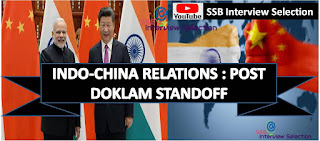1. Background.
 (a) The credit line was declared by
Narendra Modi during his first visit to Sri Lanka as the Prime Minister of India in 2015.
(a) The credit line was declared by
Narendra Modi during his first visit to Sri Lanka as the Prime Minister of India in 2015.
(b) The visit, which was the first
standalone bilateral visit by an Indian prime minister since 1987, had come in the backdrop
of increasing Chinese presence in the nation.
(c) China has been investing heavily
in Sri Lanka, developing mainly ports that could potentially be used as a base
for its navy.
(d) China, however, claims that the
investments are part of its Belt and Road Initiative that aims to link it with
Europe and Africa through the Indian Ocean.
(e) India has been Sri Lanka's major
development partner in the South Asian region for over 40 years.
(f) Over the past years, Indian foreign
direct investment in Sri Lanka has expanded considerably.
(g) Presently, Indian development
assistance mainly focuses on improvement of infrastructure, livelihood
development, education, healthcare, and capacity building.
2. Current Update.
(a) India signed an agreement with Sri
Lanka on 6 Jun 2017 to provide fresh assistance of USD 318 million as a
line of credit for the development of the nation‘s railway sector.
(b) The agreement was signed by RHS
Samaratunga, Secretary, Ministry of Finance and Mass Media and David Rasquinha,
Managing Director of India's Export-Import Bank in Colombo. India has previously
provided four lines of credit to Sri Lanka to develop its railway sector, amounting to
approximately USD 966 million. These credit facilities were
utilised to improve the country‘s
Southern and Northern railway lines and for the procurement of rolling stocks.
(c) According to Sri Lanka's Ministry
of Transport, improving passenger transportation facilities is urgently
required to attract passengers towards railways, which is a cost - effective mode of
transportation. India, Sri Lanka Sign
MoU to Build 1200 Houses In Hambantota
3. Background.
(a) India on 26 Oct 2017 signed a
Memorandum of Understanding (MoU) with Sri Lanka to build 1200 houses in
Hambantota, a southern port city of Sri Lanka.
(b) The MoU was signed by Indian High
Commissioner to Sri Lanka Taranjit Singh Sandhu and Sri Lanka's Secretary to
the Ministry of Housing and Construction W.K.K.
Athukorala.
4. Key Highlights.
(a) The 1200 houses will be
constructed through 50 model villages using Indian grant assistance of Rs 600 million.
(b) Out of these 1200 houses, 600 will
be constructed in the Southern Province, while the remaining will be
constructed across Sri Lanka with one model village in each of the 25 districts.
(c) The project will target low income
landless and homeless beneficiaries. (d) A cash grant of Rs 500000 will be
provided to each beneficiary in five installments.
(e) These projects are in continuation
of India's commitment to assist Sri Lanka in the development of housing
infrastructure.
(f) India has already committed 50000
houses in the North and East Sri Lanka, out of which nearly 46000 houses have
been completed.
(g) Construction of 4000 houses is
currently on-going in the plantation sector in Central and Uva Provinces of Sri
Lanka.
(h) In May 2017, Prime Minister
Narendra Modi committed another 10000 houses for beneficiaries in the plantation
sector.
5. About Hambantota.
(a) The coastal city of Hambantota
gained strategic significance after former President Mahinda Rajapaksa built a
massive port and an airport with huge Chinese loans. In July 2017, Rajpaksa
government sold majority stakes of the port to China to manage outstanding USD 8 billion
debts it owes China.
(b) Local residents, including
supporters of Rajapaksa, earlier protested the selling of national assets to foreign entities.
(c) Earlier in October 2017,
protesters clashed with the police outside the Indian consulate in Hambantota after media
reported government‘s move to lease out a nearby airport to India.












